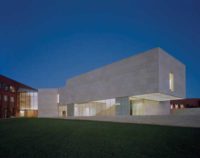Newsmaker: Kyu Sung Woo
Cambridge, Massachusetts, architect Kyu Sung Woo, FAIA, has had an eventful summer. He saw one project, graduate-student housing for Harvard University, completed in a prominent location on the Charles River. On June 12, ground broke for his nearly one-and-a-half-million-square-foot Asian Culture Complex in Gwangju, Korea, a development that will place a series of cultural and research spaces in a sky-lit, subterranean complex covered by what will be one of the city’s largest urban parks.
But of all the milestones the Seoul-born architect has REACHED recently, one of the most significant, he says, was winning the Ho-Am Prize for the arts. It marks the first time in its 17-year history that the award, a $200,000 prize commonly referred to as Korea’s Nobel Prize, has gone to an architect.
Woo moved to the United State in 1967 and completed an MA in architecture at Columbia University before receiving another Master’s—this one in urban design—from Harvard. In 1970, Woo took a position at Sert, Jackson & Associates, and then went on to co-found Woo and Williams in 1979 and his current firm, Kyu Sung Woo Architects, in 1990.
He has completed many acclaimed stateside buildings over his four decades in the US, many of them for academic institutions. Some of the architect’s most renowned work, however, has been built in Korea, where he first drew international attention for his Olympic Village designed for the 1988 games in Seoul. And he defined a style that emphasizes careful interventions attuned to the culture and topography of their sites with the contemplative Whanki Museum (1993), also in the Korean capital.
In a recent conversation, I spoke with Woo about the Asian Culture Complex, as well as his new housing for Harvard. He also shared his thoughts on winning one of the most prestigious awards for the arts in his native country.

A rendering depicting a nighttime aerial view of Kyu Sung Woo’s Asian Culture Complex.
William Hanley: Students will move into your new graduate housing building at Harvard very soon. How did you work with its highly visible site during the design process?
Kyu Sung Woo: The site had a lot of issues. [Renzo] Piano once designed a museum for it that was never built. It’s riverfront, so for the community, access to the river is very important. Also, it’s kind of the first building you see at Harvard when you arrive from Boston side.
The massing and the scale were negotiated with the community. It also has a cantilevered piece that serves as both a gateway statement for Harvard, as well as giving access to the river for the community.
WH: The new Harvard housing is on track to receive LEED certification. Have you been incorporating more sustainable elements into your work recently?
KSW: Yes. It’s a major consideration with the Asian Culture Complex. When I first looked at the site on Google Maps, it was very dense. You know Asian cities, they don’t have much open space, and even compared to other cities in Korea, Gwangju has limited open space. My desire was to somehow provide green space in the middle of the city. So what happened was, I put 1.5 million square feet of facilities underground, and the entire roof, which is flat with three levels, became a park.
We have also used alternative energy resources, natural ventilation, natural lighting, and thermal energy, in the buried structure to cut almost 40 percent of the conventional consumption. Even though it’s underground, the complex is, I would say, almost completely day-lit because of skylights.
WH: You have also chosen to incorporate into the design some existing administrative buildings, which were a flashpoint in the 1980 pro-democracy uprising centered in Gwangju. How does the complex function as a memorial to that period in recent Korean history?
KSW: The city is known for anti-establishment movements—against the Japanese in the 1920s, and others even before that. The provincial government building, at the Northern part of this project, was where much of the fighting took place in 1980 and many people died. The memory of the 1980 uprising is very important for citizens of Gwangju, and it also helped the larger Korean democracy movement, so I thought it would be important to keep the structure. It will be renovated—not just renovated—it will become the focal point, the center of the whole composition by carving out the land surrounding it for the underground complex.
WH: Your work, in both the US and Korea, is very attuned to the history running through specific sites. Have Korean history and aesthetic traditions had a great deal of influence on your work?
KSW: I’m not conscious of either Korea or the US when I work, but I’m sure it has influenced me. If I could pick one or two ways, perhaps I would say that it’s in a relationship with nature—or perhaps light.
WH: Does that relationship to Korean culture give winning the Ho-Am Prize a particular significance?
KSW: I would say that there are two reasons it is significant for me. One is that this is the first time that an architect got it. It shows architecture gaining a place in that country. There is a lot of talent coming up in the younger generations [of Korean architects]. Also, I consider it a kind of recognition of my work as being culturally sensitive. That part feels good


